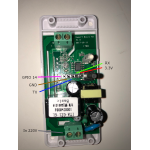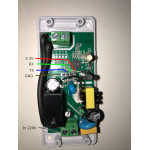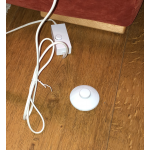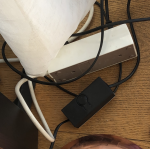Integrate Sonoff Switch to Homeassistant
06 May 2020- Pin Steckerleiste anlöten, oder besser universal Clip aus dem 3D Drucker
- Pins mit dem USB TTY Modul verbinden, aber noch nicht einstecken, siehe Bild
- Mit HomeAssistant ESPHome Dashboard neues binary erstellen
> esphome: > name: arbeitszimmer-schreibtischlampe > platform: ESP8266 > board: esp01_1m > > wifi: > ssid: !secret wifi_ssid > password: !secret wifi_password > > # Enable fallback hotspot (captive portal) in case wifi connection fails > ap: > ssid: "Arbeitszimmer Schreibtischlampe" > password: "very-secure" > > captive_portal: > > # Enable logging > logger: > > # Enable Home Assistant API > api: > > ota: > > binary_sensor: > - platform: gpio > pin: > number: GPIO0 > mode: INPUT_PULLUP > inverted: True > name: "Sonoff Basic Button" > on_press: > - switch.toggle: relay > > switch: > - platform: gpio > name: "Schreibtischlampe" > pin: GPIO12 > id: relay - esptool installieren
python3 -m pip install esptool - USB Adapter mit SonOff verbinden, siehe Bilder für die Pin-Belegung


- Beim einstecken des USB Adapters in den USB Port, den Knopf am SonOff gedrückt halten
- mit esptool flashen
pi@raspberrypi:~ $ ./.local/bin/esptool.py --port /dev/ttyUSB0 write_flash -fs 1MB -fm dout 0x0 esptool.bin esptool.py v2.7 Serial port /dev/ttyUSB0 Connecting.... Detecting chip type... ESP8266 Chip is ESP8285 Features: WiFi, Embedded Flash Crystal is 26MHz MAC: dc:4f:22:f5:b6:3a Uploading stub... Running stub... Stub running... Configuring flash size... Compressed 515872 bytes to 355877... Wrote 515872 bytes (355877 compressed) at 0x00000000 in 32.5 seconds (effective 126.9 kbit/s)... Hash of data verified. Leaving... Hard resetting via RTS pin... - Neues Gerät sollte automatisch von HomeAssistant erkannt werden "Discover new Devices"
-
Mittels 3D-gedrucktem neuem Oberteil lassen sich diese Schalter als Schalter für Lampen und sonstige Hausgeräte nutzen

